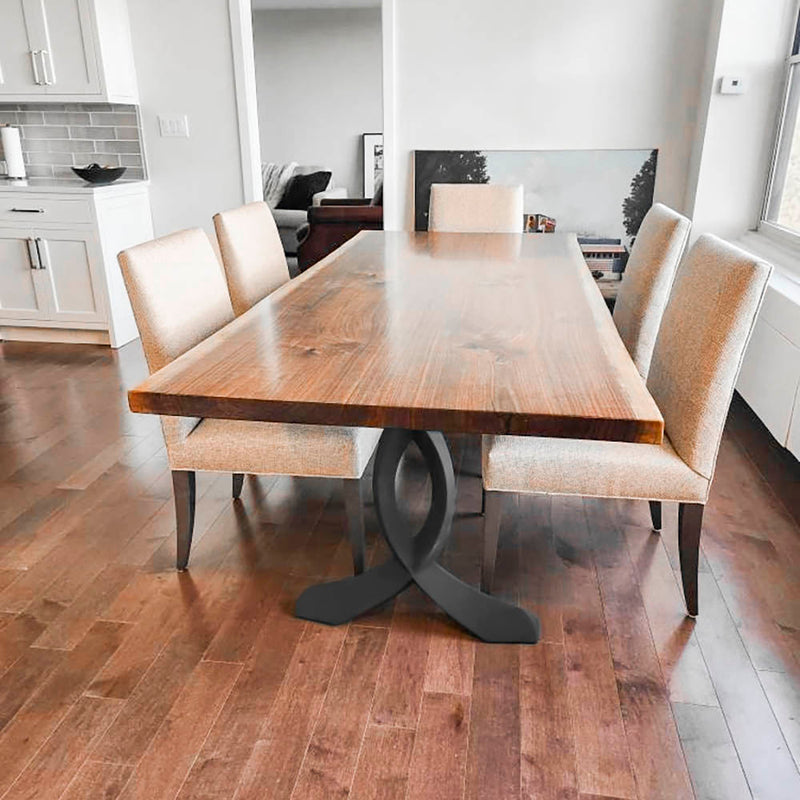From Typical to Modern: Discover the Suitable Dining Room Table Legs for Your Style
While timeless designs such as cabriole and transformed legs evoke a sense of classic class, modern styles like hairpin and geometric options offer a possibility for striking aesthetic passion. As you consider these components, the inquiry remains: how can you effortlessly incorporate these varied leg styles to develop a harmonious dining experience?
Comprehending Table Leg Styles
The range of dining-room table leg designs can dramatically affect both the aesthetic appeals and capability of the room. Each leg design adds one-of-a-kind visual components and useful features, providing to diverse design choices and usage needs. Recognizing these designs is crucial for selecting the ideal table that lines up with your overall interior layout vision.
As an example, conical legs offer a clean, timeless appearance that can enhance a space's elegance, while stand bases supply stability and make the most of legroom, making them suitable for smaller spaces. Barrette legs, a trademark of mid-century modern-day layout, present an industrial panache, enabling a ventilated, open feeling. Likewise, trestle legs evoke rustic appeal, offering robust assistance and a feeling of timelessness.
Furthermore, the selection of products plays a considerable duty. Wooden legs can bring warmth and appearance, whereas metal options typically convey a smooth, modern vibe. Eventually, recognizing table leg styles is crucial for developing a natural dining area that mirrors personal design while making sure practicality and convenience. By attentively thinking about these elements, you can boost both the aesthetic and practical charm of your eating space.
Typical Table Leg Options
When picking dining area table legs, traditional options commonly symbolize timeless beauty and craftsmanship. These styles show an abundant heritage and a dedication to top quality, making them perfect for those who appreciate traditional visual appeals.
Among one of the most legendary typical leg designs is the cabriole leg, characterized by its stylish rounded form. This layout usually features ornamental carvings and is most frequently discovered in Queen Anne and Chippendale furniture. One more prominent choice is the turned leg, which boasts a series of smooth, rounded shapes that offer a classic look while maintaining security.
Furthermore, the straight leg, while straightforward, offers a unadorned and strong framework that can blend seamlessly with a variety of tabletop styles. For those attracted to ornate describing, claw-and-ball feet legs evoke a sense of splendour and can serve as a sensational centerpiece in any type of dining space.
Last but not least, stand bases, although not purely legs, give a different typical choice that allows for sufficient legroom and can be beautifully sculpted. Each of these standard leg styles adds to the overall setting of a dining-room, weding function with visual appeal.

Modern Table Leg Styles
Modern table leg styles provide a varied variety of designs that highlight innovative materials and tidy lines. These designs often focus on functionality while serving as striking focal factors within a dining area. Minimal appearances prevail, with legs crafted from products such as metal, glass, and engineered timber, which add to a ventilated and modern feel.
One preferred style is the barrette leg, characterized by its slender, conical structure that provides stability without frustrating the tabletop (dining room table legs). This style is frequently found in mid-century contemporary furnishings and can easily complement different eating table shapes. An additional pattern is using geometric shapes, where legs may take on unbalanced or angular forms, adding aesthetic interest and a touch of creativity

Mixing Designs for One-of-a-kind Spaces
Typically, property owners look for to create special eating rooms that reflect their individual style by blending various style elements. This approach permits the unification of varied looks, causing an unified yet unique environment. Matching a rustic wood table with smooth, modern steel legs can produce a captivating contrast that boosts the area's general appeal.
Furthermore, incorporating vintage table legs with modern tabletops can evoke a feeling of history while maintaining a modern-day sensibility. Such combinations not just showcase individual taste but likewise click resources encourage creativity, permitting property owners to curate a room that feels both individual and inviting.
Color plays an important duty in this blending procedure; selecting table legs that enhance or contrast with the existing color design can boost visual rate of interest. Whitewashed legs can soften the boldness of a dark table surface, developing a balanced visual.
Tips for Picking the Right Legs
Choosing the right table legs is essential for achieving both performance and aesthetic allure in your dining space. Begin by taking into consideration the overall style of your space. Traditional setups take advantage of legs that feature detailed carvings or transformed styles, while contemporary rooms might call for sleek, minimal styles.
Following, analyze the height and security of the legs. dining room table legs. Conventional dining tables range between 28 to 30 inches in elevation, so guarantee the legs enhance this measurement for convenience. Furthermore, robust products, such as hardwood or metal, can boost stability and long life
Review the leg shape as well-- choices include directly, tapered, or stand styles. Straight legs provide a timeless appearance, while conical legs can include a touch of style. Pedestal bases provide adequate legroom and are ideal for smaller spaces.
Conclusion
In summary, selecting the ideal dining room table legs calls for cautious consideration of both site modern and typical designs. By harmonizing leg design, height, and product with the general design, a cohesive and welcoming atmosphere can blog be attained.
The range of eating space table leg styles can dramatically affect both the visual appeals and functionality of the space. Ultimately, recognizing table leg styles is crucial for producing a natural dining area that mirrors personal style while ensuring functionality and convenience.One of the most renowned traditional leg designs is the cabriole leg, characterized by its stylish bent shape. Straight legs use a classic appearance, while tapered legs can add a touch of style.In summary, choosing the perfect dining space table legs calls for careful consideration of both contemporary and traditional styles.
 Bradley Pierce Then & Now!
Bradley Pierce Then & Now! Michael Oliver Then & Now!
Michael Oliver Then & Now! David Faustino Then & Now!
David Faustino Then & Now! Tonya Harding Then & Now!
Tonya Harding Then & Now! Katey Sagal Then & Now!
Katey Sagal Then & Now!